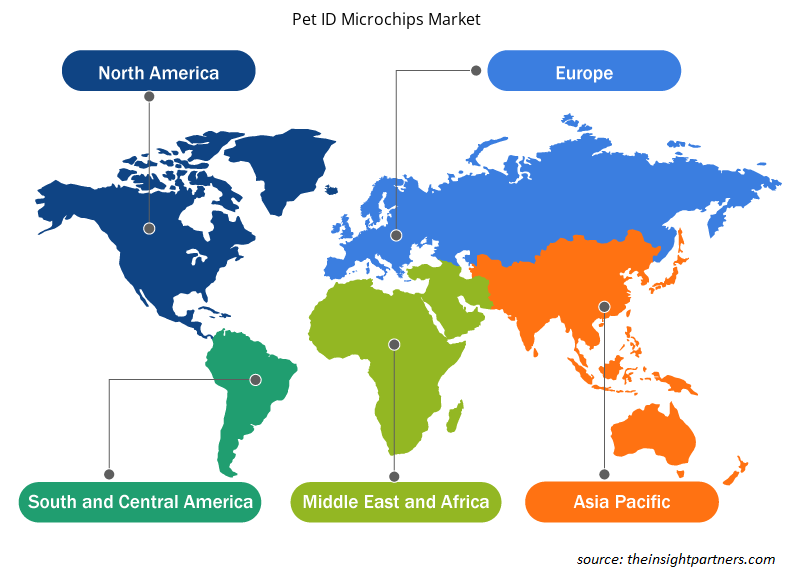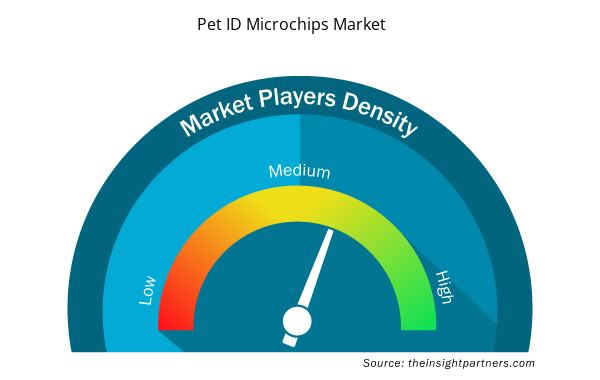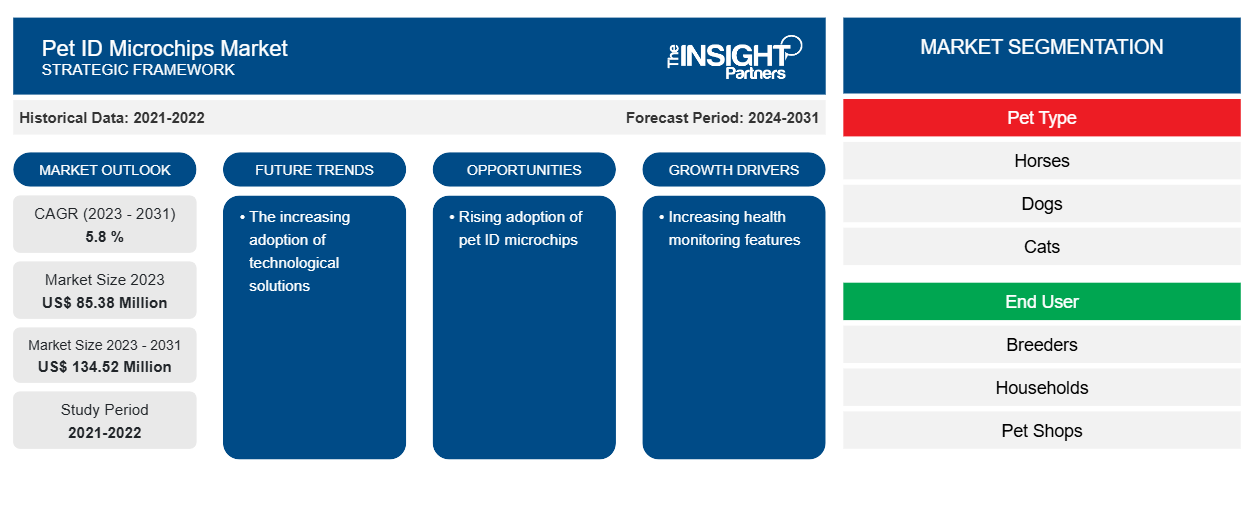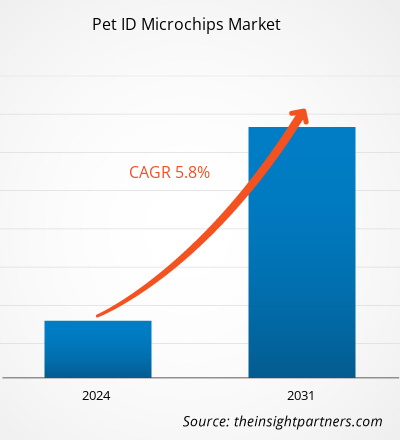Der Markt für Mikrochips zur Haustieridentifizierung soll von 85,38 Millionen US-Dollar im Jahr 2023 auf 134,52 Millionen US-Dollar im Jahr 2031 anwachsen. Der Markt soll zwischen 2023 und 2031 eine durchschnittliche jährliche Wachstumsrate von 5,8 % verzeichnen. Die zunehmende Einführung technologischer Lösungen dürfte ein wichtiger Trend auf dem Markt bleiben.
Marktanalyse für Haustier-ID-Mikrochips
Ein einzelner Chip bleibt bis zu 25 Jahre funktionsfähig und hält ein Leben lang. Die meisten aktuellen Chips arbeiten mit 134,2 kHz, in den USA sind jedoch noch einige 125-kHz-Mikrochips erhältlich. Darüber hinaus wurde die Größe des Mikrochips erheblich reduziert und die Temperaturanzeige des Haustiers beim Scannen mit einem Mikrochip-Scanner verbessert. Mikrochips sind eine effektive Methode zur Identifizierung von Haustieren, da sie im Körper eingebettet sind und daher nicht abgekaut, entfernt, zerrissen oder gefälscht werden können. Tierärzte und Tierschutzorganisationen auf der ganzen Welt begrüßen die gesetzlich vorgeschriebene Mikrochip-Kennzeichnung von Haustieren.
Marktübersicht für Haustier-ID-Mikrochips
Ein Mikrochip ist ein winziges elektronisches Gerät, das alle relevanten Informationen enthält. Auf diesem Chip befindet sich eine Nummer, mit der das Haustier genau identifiziert werden kann. Um einen Chip zu erhalten, müssen Besitzer einen Tierarzt aufsuchen, der ihn ihrem Haustier knapp unter die Haut spritzt. Der Eingriff ist schmerzhaft, daher ist keine Anästhesie erforderlich. Auf dem Mikrochip befindet sich eine Registrierungsnummer des Tierregisters. Bei Bedarf kann ein Scanner die Registrierungsinformationen des Haustiers abrufen. Mikrochips sind ideal für eine dauerhafte, manipulationssichere Identifizierung, aber kein Ersatz für ein Halsband mit aktuellen Identifikationsetiketten.
Passen Sie diesen Bericht Ihren Anforderungen an
Sie erhalten kostenlos individuelle Anpassungen an jedem Bericht, einschließlich Teilen dieses Berichts oder einer Analyse auf Länderebene, eines Excel-Datenpakets sowie tolle Angebote und Rabatte für Start-ups und Universitäten.
- Holen Sie sich die wichtigsten Markttrends aus diesem Bericht.Dieses KOSTENLOSE Beispiel umfasst eine Datenanalyse von Markttrends bis hin zu Schätzungen und Prognosen.
Markttreiber und Chancen für Mikrochips zur Haustieridentifikation
Steigende Verbreitung von Mikrochips zur Haustieridentifizierung
Verschiedene Spezialisten für Haustier-IDs bieten Haustier-ID-Mikrochips für Kunden aus allen Bereichen des Tierschutzes an, darunter Rettungsdienste, Veterinärmedizin, Hundefriseur, lokale Behörden, Züchter, Tierdienste und Zoos. Darüber hinaus bieten Haustier-ID-Anbieter in verschiedenen Regionen, wie Großbritannien und anderen, Projekte zum Schutz der Tierwelt an. So brachte MSD Animal Health im Oktober 2022 den HomeAgain Thermochip auf den Markt, einen neuen Identifikations-Mikrochip, der einen Temperatur-Biosensor enthält, der die subkutane Temperatur der Katze oder des Hundes misst. Daher treibt die zunehmende Verbreitung von Haustier-ID-Mikrochips den Markt für Haustier-ID-Mikrochips an.
Erweiterte Funktionen zur Gesundheitsüberwachung
Tragbare Accessoires sind wesentliche Elemente intelligenter Gesundheitsüberwachungssysteme für Haustiere. Sie erfassen mithilfe von Sensoren, die in Halsbänder oder Geschirre eingebettet sind, verschiedene Gesundheitsinformationen und liefern wertvolle Informationen zur Gesundheit Ihres Haustiers. Geräte wie FitBark oder Whistle werden am Halsband des Haustiers befestigt und überwachen körperliche Aktivität, Schlafmuster und Kalorienverbrauch. Sie liefern Informationen über die Fitness und das Energieniveau des Haustiers. Die Marken Tractive und Link AKC bieten GPS-fähige Halsbänder an, mit denen Sie den Standort Ihres Haustiers jederzeit verfolgen können. Dies ist besonders nützlich für Haustiere, die sich im Freien aufhalten oder zum Herumstreunen neigen. Die zunehmenden Gesundheitsüberwachungsfunktionen schaffen also mehr Möglichkeiten für den Markt.
Marktbericht zu Mikrochips für Haustier-IDs – Segmentierungsanalyse
Wichtige Segmente, die zur Ableitung der Marktanalyse für Haustier-ID-Mikrochips beigetragen haben, sind Haustierart und Endbenutzer.
- Basierend auf der Komponente ist der Markt für Mikrochips für Haustier-IDs in Pferde, Hunde, Katzen und andere unterteilt. Das Segment Pferde hatte im Jahr 2023 einen größeren Marktanteil.
- Nach Endverbraucher ist der Markt in Züchter, Haushalte, Zoohandlungen und Sonstige segmentiert.
Marktanteilsanalyse für Haustier-ID-Mikrochips nach geografischer Lage
Der geografische Umfang des Marktberichts für Haustier-ID-Mikrochips ist hauptsächlich in fünf Regionen unterteilt: Nordamerika, Asien-Pazifik, Europa, Naher Osten und Afrika sowie Süd- und Mittelamerika.
Nordamerika dominiert den Markt für Mikrochips zur Identifizierung von Haustieren. Laut der American Pet Products Association (APPA) werden die Menschen in den USA im Jahr 2022 etwa 109,6 Milliarden US-Dollar für ihre Haustiere ausgeben. Darüber hinaus werden Haustierzubehörteile immer fortschrittlicher und es gibt eine wachsende Zahl von Erfindungen und Entwicklungen in der Haustierbranche. Daher steigt die Nachfrage nach Mikrochips für Haustiere in der Region.
Regionale Einblicke in den Markt für Haustier-ID-Mikrochips
Die regionalen Trends und Faktoren, die den Markt für Mikrochips für Haustier-IDs im Prognosezeitraum beeinflussen, wurden von den Analysten von Insight Partners ausführlich erläutert. In diesem Abschnitt werden auch die Marktsegmente und die Geografie für Mikrochips für Haustier-IDs in Nordamerika, Europa, im asiatisch-pazifischen Raum, im Nahen Osten und Afrika sowie in Süd- und Mittelamerika erörtert.

- Erhalten Sie regionale Daten zum Markt für Haustier-ID-Mikrochips
Umfang des Marktberichts zu Mikrochips für Haustier-IDs
| Berichtsattribut | Details |
|---|---|
| Marktgröße im Jahr 2023 | 85,38 Millionen US-Dollar |
| Marktgröße bis 2031 | 134,52 Millionen US-Dollar |
| Globale CAGR (2023 - 2031) | 5,8 % |
| Historische Daten | 2021-2022 |
| Prognosezeitraum | 2024–2031 |
| Abgedeckte Segmente | Nach Haustierart
|
| Abgedeckte Regionen und Länder | Nordamerika
|
| Marktführer und wichtige Unternehmensprofile |
|
Marktteilnehmerdichte für Haustier-ID-Mikrochips: Auswirkungen auf die Geschäftsdynamik verstehen
Der Markt für Mikrochips zur Haustieridentifizierung wächst rasant. Dies wird durch die steigende Nachfrage der Endnutzer aufgrund von Faktoren wie sich entwickelnden Verbraucherpräferenzen, technologischen Fortschritten und einem größeren Bewusstsein für die Vorteile des Produkts vorangetrieben. Mit der steigenden Nachfrage erweitern Unternehmen ihr Angebot, entwickeln Innovationen, um die Bedürfnisse der Verbraucher zu erfüllen, und nutzen neue Trends, was das Marktwachstum weiter ankurbelt.
Die Marktteilnehmerdichte bezieht sich auf die Verteilung der Firmen oder Unternehmen, die in einem bestimmten Markt oder einer bestimmten Branche tätig sind. Sie gibt an, wie viele Wettbewerber (Marktteilnehmer) in einem bestimmten Marktraum im Verhältnis zu seiner Größe oder seinem gesamten Marktwert präsent sind.
Die wichtigsten auf dem Markt für Haustier-ID-Mikrochips tätigen Unternehmen sind:
- Pethealth Inc
- Merck & Co. Inc
- Elanco Tiergesundheit Inc.
- Avid Identification Systems Inc
- Datamars SA
- Trovan GmbH
Haftungsausschluss : Die oben aufgeführten Unternehmen sind nicht in einer bestimmten Reihenfolge aufgeführt.

- Überblick über die wichtigsten Akteure auf dem Markt für Haustier-ID-Mikrochips
Marktnachrichten und aktuelle Entwicklungen zu Mikrochips für Haustier-IDs
Der Markt für Mikrochips zur Haustieridentifikation wird durch die Erhebung qualitativer und quantitativer Daten nach Primär- und Sekundärforschung bewertet, die wichtige Unternehmensveröffentlichungen, Verbandsdaten und Datenbanken umfasst. Nachfolgend sind einige der Entwicklungen auf dem Markt für Mikrochips zur Haustieridentifikation aufgeführt:
- PetPace ™, ein führendes Unternehmen im Bereich der fortschrittlichen Gesundheitsüberwachung von Haustieren, gab die Markteinführung von PetPace 2.0 bekannt, einem KI-gestützten, lebensrettenden intelligenten Hundehalsband, das kontinuierliche, nahezu in Echtzeit medizinische Erkenntnisse zur Früherkennung, Behandlung, Überwachung und GPS-Verfolgung der Gesundheit von Hunden liefert. PetPace verbessert die Gesundheit und Lebensqualität von Haustieren durch Fernüberwachung, um Tierbesitzern ein beruhigendes Gefühl zu geben. (Quelle: PetPace, Pressemitteilung, Mai 2024.)
- International Alliance Technologies will am 26. April sein Vorzeigeprodukt auf den Markt bringen, eine Haustier-ID-Marke mit QR-Code. Die Marke ist mit einer Informationsdatenbank verbunden, die nach Aktivierung kostenlos genutzt werden kann. Die Datenbank enthält geschützte persönliche Informationen wie die Adresse und Telefonnummer des Besitzers, Krankenakten, Kontaktdaten des Tierarztes und mehr und bietet außerdem Zugang zu einem rund um die Uhr verfügbaren Kundenservice. (Quelle: International Alliance Technologies, Pressemitteilung, April 2021)
Marktbericht zu Mikrochips für Haustier-IDs – Umfang und Ergebnisse
Der Bericht „Marktgröße und Prognose für Haustier-ID-Mikrochips (2021–2031)“ bietet eine detaillierte Analyse des Marktes, die die folgenden Bereiche abdeckt:
- Marktgröße und Prognose für Pet ID-Mikrochips auf globaler, regionaler und Länderebene für alle wichtigen Marktsegmente, die im Rahmen des Projekts abgedeckt sind
- Markttrends für Mikrochips zur Haustieridentifikation sowie Marktdynamik wie Treiber, Einschränkungen und wichtige Chancen
- Detaillierte PEST/Porters Five Forces- und SWOT-Analyse
- Marktanalyse für Haustier-ID-Mikrochips mit wichtigen Markttrends, globalen und regionalen Rahmenbedingungen, wichtigen Akteuren, Vorschriften und aktuellen Marktentwicklungen
- Branchenlandschaft und Wettbewerbsanalyse mit Marktkonzentration, Heatmap-Analyse, prominenten Akteuren und aktuellen Entwicklungen auf dem Markt für Haustier-ID-Mikrochips
- Detaillierte Firmenprofile
- Historische Analyse (2 Jahre), Basisjahr, Prognose (7 Jahre) mit CAGR
- PEST- und SWOT-Analyse
- Marktgröße Wert/Volumen – Global, Regional, Land
- Branche und Wettbewerbsumfeld
- Excel-Datensatz



Report Coverage
Revenue forecast, Company Analysis, Industry landscape, Growth factors, and Trends

Segment Covered
This text is related
to segments covered.

Regional Scope
North America, Europe, Asia Pacific, Middle East & Africa, South & Central America

Country Scope
This text is related
to country scope.
Häufig gestellte Fragen
The expected CAGR of the global pet ID microchips market is 5.8 %.
The global pet ID microchips market is expected to reach US$ 134.52 million by 2031.
The increasing adoption of technological solutions is anticipated to play a significant role in the global pet ID microchips market in the coming years.
The key players holding majority shares in the global pet ID microchips market are Pethealth, Inc., Merck & Co., Inc., Elanco Animal Health, Inc., Avid Identification Systems, Inc, Datamars SA, Trovan Ltd, Virbac SA, Animalcare Group Plc, Microchip4solutions Inc, and PeddyMark Ltd.
The rising adoption of pet ID microchips and the increasing health monitoring features are the major factors that propel the global pet ID microchips market.
APAC dominates the pet ID microchips market.
Trends and growth analysis reports related to Electronics and Semiconductor : READ MORE..
The Insight Partners performs research in 4 major stages: Data Collection & Secondary Research, Primary Research, Data Analysis and Data Triangulation & Final Review.
- Data Collection and Secondary Research:
As a market research and consulting firm operating from a decade, we have published and advised several client across the globe. First step for any study will start with an assessment of currently available data and insights from existing reports. Further, historical and current market information is collected from Investor Presentations, Annual Reports, SEC Filings, etc., and other information related to company’s performance and market positioning are gathered from Paid Databases (Factiva, Hoovers, and Reuters) and various other publications available in public domain.
Several associations trade associates, technical forums, institutes, societies and organization are accessed to gain technical as well as market related insights through their publications such as research papers, blogs and press releases related to the studies are referred to get cues about the market. Further, white papers, journals, magazines, and other news articles published in last 3 years are scrutinized and analyzed to understand the current market trends.
- Primary Research:
The primarily interview analysis comprise of data obtained from industry participants interview and answers to survey questions gathered by in-house primary team.
For primary research, interviews are conducted with industry experts/CEOs/Marketing Managers/VPs/Subject Matter Experts from both demand and supply side to get a 360-degree view of the market. The primary team conducts several interviews based on the complexity of the markets to understand the various market trends and dynamics which makes research more credible and precise.
A typical research interview fulfils the following functions:
- Provides first-hand information on the market size, market trends, growth trends, competitive landscape, and outlook
- Validates and strengthens in-house secondary research findings
- Develops the analysis team’s expertise and market understanding
Primary research involves email interactions and telephone interviews for each market, category, segment, and sub-segment across geographies. The participants who typically take part in such a process include, but are not limited to:
- Industry participants: VPs, business development managers, market intelligence managers and national sales managers
- Outside experts: Valuation experts, research analysts and key opinion leaders specializing in the electronics and semiconductor industry.
Below is the breakup of our primary respondents by company, designation, and region:

Once we receive the confirmation from primary research sources or primary respondents, we finalize the base year market estimation and forecast the data as per the macroeconomic and microeconomic factors assessed during data collection.
- Data Analysis:
Once data is validated through both secondary as well as primary respondents, we finalize the market estimations by hypothesis formulation and factor analysis at regional and country level.
- Macro-Economic Factor Analysis:
We analyse macroeconomic indicators such the gross domestic product (GDP), increase in the demand for goods and services across industries, technological advancement, regional economic growth, governmental policies, the influence of COVID-19, PEST analysis, and other aspects. This analysis aids in setting benchmarks for various nations/regions and approximating market splits. Additionally, the general trend of the aforementioned components aid in determining the market's development possibilities.
- Country Level Data:
Various factors that are especially aligned to the country are taken into account to determine the market size for a certain area and country, including the presence of vendors, such as headquarters and offices, the country's GDP, demand patterns, and industry growth. To comprehend the market dynamics for the nation, a number of growth variables, inhibitors, application areas, and current market trends are researched. The aforementioned elements aid in determining the country's overall market's growth potential.
- Company Profile:
The “Table of Contents” is formulated by listing and analyzing more than 25 - 30 companies operating in the market ecosystem across geographies. However, we profile only 10 companies as a standard practice in our syndicate reports. These 10 companies comprise leading, emerging, and regional players. Nonetheless, our analysis is not restricted to the 10 listed companies, we also analyze other companies present in the market to develop a holistic view and understand the prevailing trends. The “Company Profiles” section in the report covers key facts, business description, products & services, financial information, SWOT analysis, and key developments. The financial information presented is extracted from the annual reports and official documents of the publicly listed companies. Upon collecting the information for the sections of respective companies, we verify them via various primary sources and then compile the data in respective company profiles. The company level information helps us in deriving the base number as well as in forecasting the market size.
- Developing Base Number:
Aggregation of sales statistics (2020-2022) and macro-economic factor, and other secondary and primary research insights are utilized to arrive at base number and related market shares for 2022. The data gaps are identified in this step and relevant market data is analyzed, collected from paid primary interviews or databases. On finalizing the base year market size, forecasts are developed on the basis of macro-economic, industry and market growth factors and company level analysis.
- Data Triangulation and Final Review:
The market findings and base year market size calculations are validated from supply as well as demand side. Demand side validations are based on macro-economic factor analysis and benchmarks for respective regions and countries. In case of supply side validations, revenues of major companies are estimated (in case not available) based on industry benchmark, approximate number of employees, product portfolio, and primary interviews revenues are gathered. Further revenue from target product/service segment is assessed to avoid overshooting of market statistics. In case of heavy deviations between supply and demand side values, all thes steps are repeated to achieve synchronization.
We follow an iterative model, wherein we share our research findings with Subject Matter Experts (SME’s) and Key Opinion Leaders (KOLs) until consensus view of the market is not formulated – this model negates any drastic deviation in the opinions of experts. Only validated and universally acceptable research findings are quoted in our reports.
We have important check points that we use to validate our research findings – which we call – data triangulation, where we validate the information, we generate from secondary sources with primary interviews and then we re-validate with our internal data bases and Subject matter experts. This comprehensive model enables us to deliver high quality, reliable data in shortest possible time.


 Holen Sie sich ein kostenloses Muster für diesen Bericht
Holen Sie sich ein kostenloses Muster für diesen Bericht